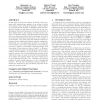Free Online Productivity Tools
i2Speak
i2Symbol
i2OCR
iTex2Img
iWeb2Print
iWeb2Shot
i2Type
iPdf2Split
iPdf2Merge
i2Bopomofo
i2Arabic
i2Style
i2Image
i2PDF
iLatex2Rtf
Sci2ools
106
click to vote
MOBIHOC
2007
ACM
2007
ACM
Capacity of a wireless ad hoc network with infrastructure
In this paper we study the capacity of wireless ad hoc networks with infrastructure support of an overlay of wired base stations. Such a network architecture is often referred to as hybrid wireless network or multihop cellular network. Previous studies on this topic are all focused on the twodimensional disk model proposed by Gupta and Kumar in their original work on the capacity of wireless ad hoc networks. We further consider a one-dimensional network model and a two-dimensional strip model to investigate the impact of network dimensionality and geometry on the capacity of such networks. Our results show that different network dimensions lead to significantly different capacity scaling laws. Specifically, for a one-dimensional network of n nodes and b base stations, even with a small number of base stations, the gain in capacity is substantial, increasing linearly with the number of base stations as long as b log b n. However, a two-dimensional square (or disk) network requires a l...
Ad Hoc Networks | Capacity Scaling Behaviors | Capacity Scaling Laws | MOBIHOC 2007 | Wireless Networks |
Related Content
| Added | 24 Dec 2009 |
| Updated | 24 Dec 2009 |
| Type | Conference |
| Year | 2007 |
| Where | MOBIHOC |
| Authors | Benyuan Liu, Patrick Thiran, Donald F. Towsley |
Comments (0)

